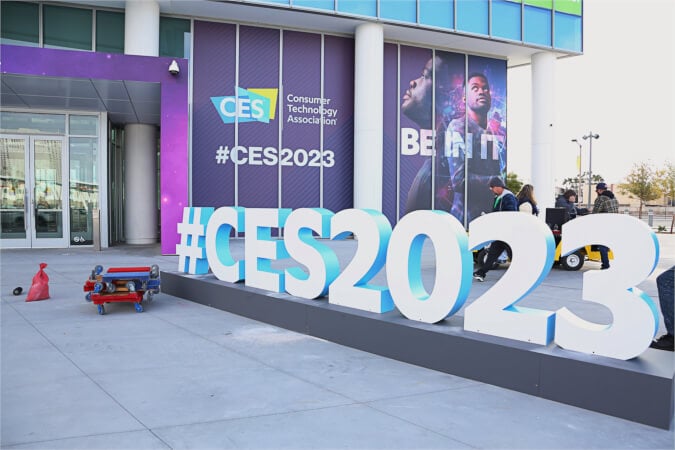CES 2023: Environmental Tech Innovations Unveiled
Many electronics companies showcased their newest innovations at CES 2023 in Las Vegas with a common focus on reducing industry emissions and confirming commitments to sustainability.
The Consumer Electronics Show (CES) is one of the most influential tech events in the world–and with good reason. CES 2023 event showed just how far the electronics industry has come in its efforts to reduce environmental impact. Companies are enhancing their commitments to sustainable supply chains and reducing emissions while showing off their latest innovations.

CES 2023. Image used courtesy of the Consumer Technology Association
This article looks at five new environmentally-friendly electronics products companies brought to CES 2023.
Drive-and-Fly eVTOL Vehicle
A US-based startup, Aska, debuted a new electric vertical takeoff and landing (eVTOL) vehicle with drive-and-fly capabilities. The A5 is a four-seat vehicle with tandem wings that can be stowed for drive mode on top of the SUV-sized model.
The hybrid-electric propulsion system is powered by lithium-ion batteries and has a gas engine for range extension. The flight range is 250 miles, and at least 30 minutes of reserve flight time. While the wings are stowed, the vehicle is powered by in-wheel motors. Six propellors on the wings allow for vertical lift and thrust, but it can also take off and land conventionally, which would reduce energy consumption.

A5 drive-and-fly eVTOL vehicle. Image used courtesy of Aska
Aska is backed by private investors and has received pre-orders for nearly 100 vehicles. The company is targeting certification of its vehicle by 2026. While the A5 can be driven on the road, any takeoff or landing has to occur at an FAA-approved site.
Electric Boats
Candela, a Swedish-based startup devoted to changing marine transport, showcased their brand new C-8 electric-powered hydrofoil speedboat. This model is capable of traveling for over two hours at 20 knots - about 23 mph - which gives it a one-charge range of about 46 miles.
Due to their environmental benefits and fuel cost savings, electric-powered boats are becoming more popular. They also offer a smoother and quieter ride, as the sleek foiling designs allow the boat to travel in a minimally disruptive way by lifting the hull above the water at faster speeds. The quieter experience offers a more comfortable ride for passengers as well without the loud noise of traditional gas-powered boats.

Candela C-8 electric-powered boat. Image used courtesy of Candela
150 brand-new C-8 models have already been manufactured and sold. It is available for roughly $400,000 and is hoping to become the new luxury vehicle of the marine industry.
Next steps for the company include expanding its technology to electric ferries, the first 30-passenger prototype expected to be released in Sweden this summer.
Electric Farming
John Deere revealed two new farming and construction technologies designed to help customers increase productivity and sustainability.
The ExactShot technology helps farmers reduce the amount of fertilizer they use from the start of planting by up to 60%. Using sensors and robotics, the technology registers when each seed is placed into the soil. As it is being planted, the robot will then spray the exact amount of fertilizer needed, which is about 0.2 ML, onto the seed.

ExactShot technology. Image used courtesy of John Deere
The ExactShot is expected to save over 93 million gallons of fertilizer annually while reducing waste, and supporting farmers to increase production as the global population rises.
For construction purposes, John Deere also showcased a new electric excavator.

Electric excavator powered by Kreisel batteries. Image used courtesy of John Deere
The new excavator is powered by Kreisel batteries; Kreisel’s charging technology claims to offer faster and less expensive grid connections. It also claims to improve reliability, performance, and safety for construction workers while also reducing noise and air pollution.
Smart Irrigation
An AgTech company, Lumo, showcased its smart irrigation value, the Lumo smart valve.

Lumo smart value. Image used courtesy of Lumo
The valve is designed to help growers save water, reduce costs, and improve crop quality. Agricultural irrigation uses 70% of global freshwater and as concerns for water scarcity increase, finding ways to improve water efficiency is important.
It is the first wireless, internet-connected valve on the market to have a built-in controller, and flow and pressure sensors, giving growers control and visibility into their irrigation system's health.
The company has already committed more than half of its 2023 inventory to early-access customers, strongly supporting the future of irrigation and agriculture.
Tracking Food’s Carbon Footprint
GreenSwapp uses code to calculate your food’s carbon footprint.

Food’s carbon footprint. Image used courtesy of Adobe Stock
Currently marketed to restaurants, the Amsterdam-based company tracks the impact of a product from production to delivery using life-cycle analysis, hoping to help restaurants make more informed decisions about their menu offerings.
Life Cycle Analysis is the scientific calculation of any product’s climate impact. It is influenced by production (where the item was grown or made), processing, packaging (cardboard, plastic, or none), to delivery (what was the method of transport). All stages of this life cycle can contribute to the amount of fossil fuels used to bring a product to your table.
The impact of many products has already been researched and reviewed by universities and institutions, at GreenSwapp, they are working to standardize the impact to be easily compared against one another. This could influence where restaurants source their food and may impact supply chain emissions.






